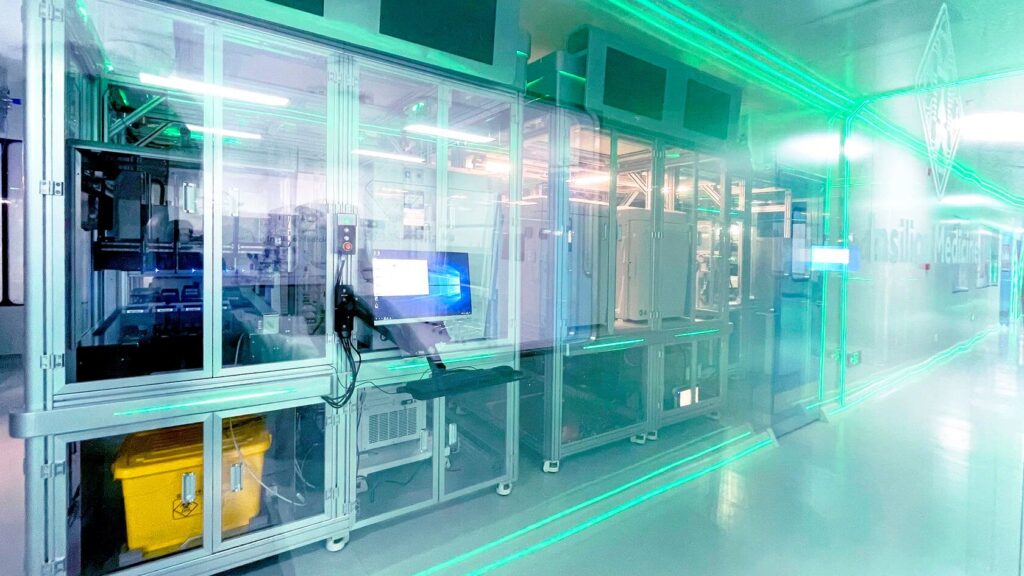Artificial intelligence (AI) drug developer Insilico Medicine says it is planning late-stage trials for its lead clinical candidate rentosertib following publication today of positive mid-stage safety and efficacy data for the idiopathic pulmonary fibrosis (IPF) candidate.
Rentosertib (formerly called ISM001-055) is a drug candidate developed internally by Insilico using generative AI. The drug is designed to treat IPF by targeting Traf2- and NCK- interacting kinase (TNIK), a serine/threonine kinase whose activation plays a crucial role in cellular processes that include signal transduction pathways essential for fibrosis development.
The Phase IIa trial (NCT05938920), conducted across 22 sites in China, was a double-blind, placebo-controlled study that enrolled 71 IPF patients who were randomized to receive placebo (17 patients), 30 mg rentosertib once daily (QD; 18 patients), 30 mg rentosertib twice daily (BID; 18 patients), or 60 mg rentosertib QD (18 patients) for 12 weeks.
All four doses showed treatment-emergent adverse events (TEAEs) ranging from 70.6% (12 of 17) placebo patients to 83.3% (15 of 18) for both 30 mg rentosertib BID and 60 mg rentosertib QD—rates similar to those of patients concurrently taking or not taking standard-of-care antifibrotic therapy and thus deemed to meet the study’s primary endpoint.
The data also showed treatment with rentosertib to have led to improved lung function, with patients receiving 60 mg QD of the drug experiencing the greatest mean improvement as measured by forced vital capacity (FVC), one of several secondary endpoints of the study. Those patients showed a mean increase of +98.4 mL, compared to a mean decline of -20.3 mL among patients dosed with placebo.
“These results suggest that targeting TNIK with rentosertib is safe and well tolerated and warrants further investigation in larger-scale clinical trials of longer duration,” a team of 27 researchers led by Insilico’s founder, Chairman, Executive Director, and CEO Alex Zhavoronkov, PhD, and the trial’s lead investigator Zuojun Xu, MD, of Peking Union Medical College, concluded in a paper published today in Nature Biotechnology.
Why did the 60 mg QD outperform the two 30 mg doses?
“Superior performance of the 60 mg QD dose is due to dose-dependent pharmacokinetic and pharmacodynamic effects. Efficacy is likely AUC-driven, and the 60 mg group facilitates the proper time above target to enhance efficacy,” Zhavoronkov told GEN Edge. “The 60mg group also has higher plasma drug exposures, with greater AUC₀–t, Cmax, and Ctrough values compared to the 30 mg group.
“Also, the serum proteomic analysis revealed a broader and more robust downregulation of fibrosis-associated biomarkers at the 60 mg dose, suggesting a potentially stronger pharmacodynamic effect,” he added.
Future dosing arm
That performance means that the 60 mg QD will likely be a dosing arm in future trials, Zhavoronkov said, though additional dosing strategies and higher/lower doses may also be explored: “Dosage moving forward remains confidential as things have not been finalized.”
Results from the trial also showed dose- and time-dependent changes in serum protein levels and FVC after 12 weeks of treatment—changes that according to Insilico further support rentosertib’s anti-fibrotic and anti-inflammatory effects.
In the high-dose group, fibrosis-associated proteins such as COL1A1, MMP10, and FAP showed significant reductions that correlated with improvements in FVC—considered the gold-standard metric for assessing the lung function of patients with IPF and response to therapeutic intervention—while interleukin 10 (IL-10), an anti-inflammatory cytokine, showed an increase consistent with a shift toward reduced inflammation.
“This suggests rentosertib not only targets fibrosis but also modulates immune pathways, providing mechanistic support for its therapeutic effect in IPF,” Zhavoronkov said. “Collectively, these findings are consistent with preclinical observations and provide valuable guidance for dose selection and biomarker identification in future clinical validations.”
In addition to FVC, the trial’s secondary endpoints included pharmacokinetic dynamics (Cmax, Ctrough, tmax, AUC0–t/!/$ and t1/2), diffusion capacity of the lung for carbon monoxide, forced expiry volume in 1 second, change in the Leicester Cough Questionnaire score, change in 6-minute walk distance, and the number and hospitalization duration of acute exacerbations of IPF.
“This study demonstrates that rentosertib has the potential to provide meaningful clinical benefits for IPF patients, which is truly exciting,” Xu stated.
Xu acknowledged, however: “The sample size in each patient group was relatively limited, and these findings will need to be validated in larger cohort studies.”
In the works
Those studies are in the works, Zhavoronkov said: “Insilico Medicine plans to initiate Phase III trials in China and Phase IIb trials in the U.S. CDE [China’s Center for Drug Evaluation] and FDA meetings are currently ongoing.”
“The China Phase III trial is likely expected to include 500+ patients, and the US Phase IIb trial is likely to include 200+ patients,” he added. “We are planning to start in Q4 2025.”
Zhavoronkov added that the positive Phase IIa data for rentosertib constituted the first-ever published proof-of-concept to show promising efficacy as well as safety results for a drug entirely discovered and designed using generative AI.
“The study demonstrated both manageable safety and promising potential for clinically meaningful improvement in lung function. That makes it the first peer-reviewed, prospective clinical trial to show therapeutic efficacy for an AI-discovered drug in humans and crosses the threshold from safety to proof-of-concept efficacy in a patient population,” Zhavoronkov asserted.
Insilico’s publication of Phase IIa data comes a month after another AI-based drug developer, Recursion, halted development of a preclinical IPF candidate—REC-4209, an oral, reversible treatment—among four programs, as part of a pruning intended to reprioritize the company’s pipeline by sharpening its therapeutic focus on cancer and rare disease programs.
Insilico is working to validate findings from the Chinese trial and earlier clinical studies of rentosertib through a parallel Phase IIa trial (NCT05975983) now enrolling patients in the United States. The study is projected to enroll a total of 60 patients and achieve primary completion in February 2026.
“At present, the U.S. Phase IIa study has screened 22 patients and enrolled eight. These eight patients have completed the 12-week study treatment,” Zhavoronkov said.
In addition to being published, the rentosertib data was also presented orally and via poster at the American Thoracic Society (ATS) 2025 International Conference.
Peer-reviewed publications
The Nature Biotechnology paper with rentosertib data is one of numerous peer-reviewed publications in 15 months about the company’s candidates—and the third about the IPF candidate. In February, researchers from Insilico and two partner institutions published a study in Aging and Disease concluding that rentosertib, then known as ISM001-055, suppressed various aging processes, and that its mechanism of action offered a promising therapeutic approach for treating age-related diseases.
Insilico researchers chronicled the drug’s discovery and early development in Nature Biotechnology in March 2024, detailing a novel target discovered by Insilico’s target identification engine, PandaOmics, and a novel molecular structure designed by its generative chemistry engine, Chemistry42. Both are specific-function platforms within the company’s AI platform, Pharma.AI.
On May 23, researchers detailed in Nature Communications their discovery of a novel small-molecule inhibitor of ENPP1, including data that showed validation of ENPP1 inhibition in preclinical models as a promising immunotherapy strategy through safe and effective activation of the cGAS-STING pathway consisting of two proteins, cyclic GMP–AMP synthase (cGAS) and Stimulator of Interferon Genes (STING).
In between, Insilico published papers in Nature Biotechnology covered the development of a generative AI model that designed new small-molecule candidates targeting the cancer-driving KRAS protein by pairing a quantum computer with classical computing methods (January 2025); and the discovery of a treatment for inflammatory bowel disease (IBD) through Insilico’s Chemistry42 platform (December 2024).
The rentosertib programs in the U.S. and China lead a pipeline that features 31 programs. Between 2021-2024, 22 of those programs advanced from project initiation to nomination of preclinical candidates in 12 to 18 months, compared to the traditional drug discovery timeframe of 2-1/2 to 4 years. Each project required synthesis and testing of only about 60 to 200 molecules, with a 100% success rate from preclinical candidate nomination to investigational new drug (IND)-enabling stage.
“Insilico’s cost per program is only $3 million to $5 million to reach developmental candidate, compared to industry averages that can reach over hundreds of millions of dollars,” Zhavoronkov said.


